Continuous learning is at the heart of excellence in massage therapy. Staying informed and expanding your skills not only benefits your clients but also keeps you engaged and inspired in your work. Whether you’re a massage therapy student eager to learn more, a new therapist building a foundation, or an experienced professional aiming to refine your techniques, there’s always something new to learn.
We’ve put together a list of 15 essential books that every massage therapist should consider adding to their library. This carefully selected collection covers a variety of topics, including advanced massage techniques, effective business practices, assessment and clinical skills, ethical considerations, and the profound connection between mind and body.
These massage books offer valuable insights and practical guidance that can help you enhance your massage skills, improve client relationships, and grow your practice. From understanding myofascial meridians to mastering therapeutic massage methods, each title provides tools and knowledge to support your professional development in the field of massage therapy.
The Massage Therapist’s Essential Reading List
To help you grow as a massage therapist, we’ve selected 15 exceptional books that offer fresh ideas and advanced concepts. These titles explore topics beyond the basics, introducing unique perspectives that can enhance your professional skills. While the majority of these books provide a deeper understanding and innovative approaches to massage therapy beyond what is typically covered in entry-level massage textbooks, a few focus on clarifying foundational concepts and skills, such as Trail Guide to the Body and Basic Clinical Massage Therapy. Even these foundational texts can offer experienced therapists a beneficial refresher and present new concepts that may have been previously overlooked or forgotten. We’ve listed the latest editions and publish dates for many of these massage therapy books to ensure you have access to the most up-to-date information. However, if only older editions are available, rest assured that these versions still serve as valuable resources, continuing to provide essential insights and techniques that can enrich your practice.

Trail Guide to the Body
By Andrew Biel
Trail Guide to the Body is an invaluable resource for massage therapists seeking to deepen their anatomical knowledge and enhance their palpation skills. This comprehensive guide to musculoskeletal anatomy is renowned for its detailed illustrations, clear instructions, and comprehensive coverage. It makes learning muscles and anatomy engaging and practical, and serves as both a study guide for massage students and a reference book for seasoned professionals.
Why It’s Worth Reading
Understanding anatomy is fundamental for every massage therapist. Trail Guide to the Body enhances your ability to identify muscles, bones, tendons, ligaments, and other structures, which can significantly improve your hands-on techniques and client outcomes. The palpation exercises are particularly helpful for translating knowledge into practice. Even if you’re familiar with the basics, revisiting this popular massage book can provide a beneficial refresher and introduce new perspectives that may enhance your clinical massage skills.
Key Features and Benefits
- Improved Anatomical Knowledge: Detailed illustrations simplify complex concepts. They accurately depict muscle groups, bones, and other anatomical structures, aiding in precise identification and understanding.
- Practical Skills: Step-by-step guidance on how to palpate various body parts effectively, improving tactile sensitivity and accuracy in assessments.
- Functional Anatomy: Insights into how different anatomical structures work together, helping therapists apply their knowledge practically during treatments.
- Clinical Applications: Real-world scenarios and case studies that demonstrate how anatomical knowledge translates into effective massage therapy practices.
- User-Friendly Learning: The approachable language makes it suitable for therapists at all levels.
My Experience
I’ve found this massage book to be an invaluable resource throughout my career. The way it breaks down anatomy has helped me deepen my understanding and confidence when working with clients.
Studying for the MBLEx? Try a practice test to see if you’re ready.
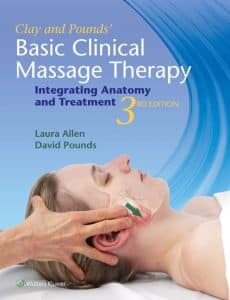
Basic Clinical Massage Therapy
By James H. Clay and Laura Allen (3rd Edition, 2015)
Basic Clinical Massage Therapy: Integrating Anatomy and Treatment bridges the gap between detailed anatomy and practical massage techniques, helping therapists build a strong foundation in both areas. The book features realistic illustrations layered over photographs of live models, making it easier to visualize muscles and understand how to treat them effectively. Additionally, it includes comprehensive clinical case studies and palpation exercises that enhance the application of anatomical knowledge in real-world settings.
Why It’s Worth Reading
For massage therapists looking to enhance their clinical skills, this practical book offers clear instructions on integrating anatomical knowledge with hands-on treatment. The combination of detailed visuals, step-by-step techniques, and interactive learning tools provides valuable insights that can improve your practice and client outcomes, regardless of your massage niche. Basic Clinical Massage Therapy goes beyond what is typically covered in entry-level massage textbooks, offering advanced concepts that can benefit both new and experienced therapists by providing a thorough refresher and introducing innovative approaches to clinical massage therapy.
What You’ll Gain
- Enhanced Anatomical Understanding: Detailed illustrations show exactly where muscles are located and how they function, aiding in more precise treatments and improving your ability to target specific muscle groups effectively.
- Practical Application: Step-by-step instructions for a variety of massage techniques that you can incorporate into your sessions, including both traditional and modern methods.
- Clinical Insights: Real-world case studies and examples that demonstrate how to apply anatomical knowledge in different therapeutic scenarios, enhancing your problem-solving skills and treatment planning.
- Updated Best Practices: The third edition includes new photographs, learning objectives, and visual draping guides that reflect current industry standards.
- Expertise in Thermal Therapies: Gain knowledge on applying heat therapy to manage pain and cryotherapy to reduce inflammation effectively within various types of massage. This enhances your ability to improve client comfort and address specific therapeutic needs across different massage styles.
Unique Features
- Interactive Learning: Includes case studies, review questions, and palpation exercises to reinforce your understanding and allow for practical application of the concepts learned.
- Expert Insights: Authored by experienced professionals, the book offers valuable perspectives on clinical massage therapy, combining academic knowledge with practical experience.
- Client-Centered Approach: Emphasizes safe and effective treatment strategies tailored to individual client needs, promoting a personalized approach to massage therapy.
- Comprehensive Educational Tools: Features detailed anatomical illustrations, functional anatomy sections, and step-by-step guides that support both visual and hands-on learners.
My Experience
This book has been a valuable addition to my professional library. The comprehensive coverage of anatomy and practical massage techniques provides fresh perspectives that enhance my approach to client care. The detailed illustrations and layered photographs of live models have improved my ability to visualize muscle structures and apply manual therapy treatment techniques more effectively. This book has deepened my understanding and refined my techniques, contributing to better client outcomes and a more informed practice.
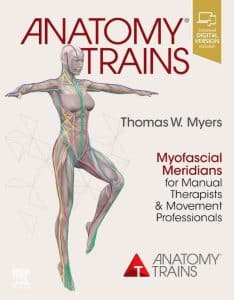
Anatomy Trains
By Thomas W. Myers (4th Edition, 2020)
This interesting massage book explores the interconnectedness of the body’s myofascial system. Anatomy Trains is essential for massage therapists and bodyworkers who seek to deepen their understanding of how fascia influences movement, posture, and overall body mechanics. It is especially helpful for therapists who use myofascial release (MFR) techniques or offer structural integration work like Rolfing. By understanding these myofascial lines, manual therapists can enhance their ability to assess and treat postural and movement dysfunctions.
Why It’s Worth Reading
Anatomy Trains: Myofascial Meridians for Manual Therapists and Movement Professionals, provides valuable insights into the role of fascia in healthy movement and posture, going beyond information commonly covered in entry-level massage textbooks. For massage therapists looking to deepen their understanding of the body’s interconnected systems, this book offers practical concepts that can improve therapeutic outcomes and client satisfaction. The comprehensive exploration of myofascial anatomy and its functional applications makes it an essential resource for both novice and experienced therapists.
What You’ll Gain
- Holistic Understanding of the Body: Learn how fascia connects muscles in continuous lines, affecting movement patterns and posture.
- Advanced Assessment Techniques: Gain tools for analyzing structural imbalances and movement restrictions.
- Enhanced Treatment Strategies: Discover methods for addressing pain and dysfunction by working with the myofascial meridians.
- Improved Client Assessments: Conduct more comprehensive evaluations by considering the body’s myofascial network, leading to more accurate diagnoses and effective interventions.
- Innovative Approaches to Common Issues: Explore new methods for treating chronic pain, improving posture, and enhancing athletic performance through myofascial therapy.
Unique Features
- Comprehensive Myofascial Anatomy: Detailed exploration of the body’s myofascial meridians, illustrating how muscles and connective tissues form continuous lines throughout the body.
- Functional Applications: Insight into how myofascial connections affect movement patterns and posture, with techniques for identifying and addressing fascial restrictions.
- Detailed Illustrations: Visual representations of myofascial lines help you grasp complex concepts.
- Latest Research: Includes new evidence-based findings on fascia and movement, ensuring the information is current and relevant.
- Multidimensional Approach: Integrates insights applicable to massage therapy, movement therapy, and other manual therapies.
- Interactive Learning Tools: Features case studies, review questions, and practical exercises that reinforce understanding and facilitate the application of myofascial massage principles in real-world scenarios.
My Experience
The insights gained from Anatomy Trains have deepened my appreciation for the body’s intricate interconnectedness, enabling me to offer more holistic approach to massage therapy. Understanding the myofascial connections has allowed me to address clients’ issues more effectively, leading to better results for many clients. The book’s clear illustrations and practical techniques have enhanced my ability to develop targeted treatment plans, ensuring that each session is both effective and tailored to the individual client’s needs.
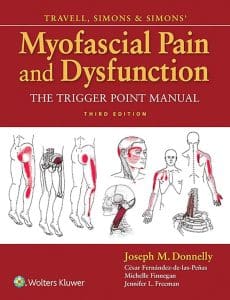
Myofascial Pain and Dysfunction
By Joseph M. Donnelly et al. (3rd Edition, 2018)
This authoritative text serves as a comprehensive guide to understanding and treating myofascial pain through trigger point therapy. Building on the pioneering work of Drs. Janet Travell and David Simons, the third edition integrates the latest research and evidence-based practices to help therapists effectively address muscle pain and dysfunction.
Why It’s Worth Reading
For massage therapists aiming to specialize in therapeutic massage for pain management, this manual offers in-depth knowledge of trigger points and their role in musculoskeletal pain. It equips you with the tools to identify and treat trigger points, enhancing your ability to alleviate clients’ discomfort and improve their quality of life. Additionally, you will learn common trigger point referral patterns, techniques for effective palpation of trigger points, and the essential massage terminology related to trigger point therapy. The insights provided are valuable across various types of massage, making it an essential resource for therapists practicing styles ranging from deep tissue massage and Swedish massage to sports massage and even chair massage. By integrating these versatile techniques, you can adapt your approach to suit different client needs and enhance the effectiveness of your treatments regardless of the massage style you use in your practice.
What You’ll Gain
- Comprehensive Understanding of Trigger Points: Learn about the physiology of trigger points and how they contribute to myofascial pain syndromes.
- Effective Treatment Techniques: Discover evidence-based methods for deactivating trigger points and relieving muscle pain.
- Clinical Application: Gain insights into integrating trigger point therapy into your practice, with guidance on assessment and treatment planning.
Unique Features
- Detailed Pain Maps: The book includes iconic pain point images that help you identify typical referral patterns associated with specific trigger points.
- Updated Research: Incorporates the latest findings in the field, ensuring that your practice is aligned with current best practices.
- Learning Aids: Features case studies, learning objectives, and review questions to reinforce your understanding and application of the material.
My Experience
Studying Myofascial Pain and Dysfunction: The Trigger Point Manual, as well as Travell & Simons’ original 2-volume set has been transformative for my massage therapy and physical therapy practice. The detailed explanations and practical techniques have enabled me to more effectively address clients’ chronic pain issues, leading to significant improvements in their well-being.

Anatomy of Movement
By Blandine Calais-Germain (2007)
This book offers an engaging exploration of the musculoskeletal system and its role in human movement. Featuring over a thousand detailed illustrations, it guides readers through the muscles, bones, ligaments, and joints of the body, emphasizing how these structures work together during physical activities like dance, exercise, and therapeutic practices.
Why It’s Worth Reading
For massage therapists aiming to deepen their understanding of anatomy and movement, Anatomy of Movement provides clear and accessible insights. It bridges the gap between anatomical knowledge and practical application, helping you comprehend how the body’s structures influence motion, which can enhance your massage techniques and client outcomes.
What You’ll Gain
- Comprehensive Anatomical Knowledge: Detailed visuals make complex concepts easier to grasp, enriching your understanding of the musculoskeletal system.
- Functional Insights: Learn how anatomical structures relate to movement, aiding in the assessment and treatment of clients’ physical issues.
- Enhanced Practice Skills: Apply this knowledge to improve your therapeutic massage techniques and address movement-related concerns effectively.
Unique Features
- Extensive Illustrations: Over a thousand drawings provide a visual aid that simplifies learning and retention.
- Focus on Practical Application: Emphasizes the functional relationships of anatomy in various physical disciplines, making it relevant to everyday practice.
- Accessible Language: Written in clear, straightforward terms suitable for both students and seasoned professionals.
My Experience
Anatomy of Movement has been a valuable addition to my professional therapy library. It has deepened my appreciation of how the body’s structures contribute to movement, allowing me to tailor my massage therapy approaches to better meet each client’s unique needs.
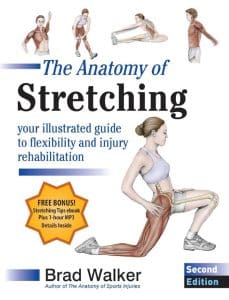
The Anatomy of Stretching
By Brad Walker (2nd Edition, 2011)
This comprehensive guide offers a detailed exploration of stretching exercises designed to improve flexibility, enhance athletic performance, and assist in injury rehabilitation. With clear instructions and over 135 stretches, the book provides massage therapists with practical tools to help clients increase their range of motion and reduce muscle tension.
Why It’s Worth Reading
For massage therapists looking to incorporate effective stretching techniques into their practice, this book serves as a valuable resource. It expands your repertoire of methods to support clients in achieving better mobility and aids in preventing injuries related to muscle tightness. The detailed stretching exercises and anatomical insights can be particularly beneficial for therapists who offer assisted stretching, providing them with structured approaches to enhance client flexibility and performance. Additionally, the information in this book supports the development of self-care home programs for clients, enabling therapists to design personalized stretching routines that clients can follow outside of therapy sessions. Furthermore, the book offers guidance that therapists can use to create their own self-care routines, ensuring you maintain your own flexibility, prevent burnout, and reduce the risk of therapist injury. By integrating these techniques, you can offer a more comprehensive and supportive approach to your clients’ flexibility and rehabilitation needs while also taking care of your personal well-being.
What You’ll Gain
- Extensive Stretch Library: Access a wide variety of stretches targeting all major muscle groups.
- Improved Client Outcomes: Learn how to use stretching to complement massage therapy, enhancing flexibility and reducing the risk of injury.
- Anatomical Understanding: Detailed illustrations help you visualize the muscles involved in each stretch, deepening your knowledge of functional anatomy.
Unique Features
- Step-by-Step Instructions: Clear guidance ensures each stretch is performed safely and effectively.
- Injury Rehabilitation Focus: Specific stretches designed to aid recovery from common injuries.
- Updated Content: The second edition includes new stretches and expanded information on physiology and anatomy.
My Experience
Integrating techniques from The Anatomy of Stretching: Your Illustrated Guide to Flexibility and Injury Rehabilitation into my practice has allowed me to offer more comprehensive treatments to my clients and patients. The detailed explanations and visuals have made it easier to recommend appropriate stretches for their needs, leading to improved flexibility and movement.

Job’s Body
By Deane Juhan (3rd Edition, 2003)
Job’s Body: A Handbook for Bodywork offers an insightful exploration of the physiological and psychological aspects of bodywork. Blending science with philosophy, Deane Juhan examines how touch influences the body’s structure and function, and how it contributes to healing and personal growth.
Why It’s Worth Reading
For massage therapists interested in the profound effects of touch on the human body and mind, this book provides a comprehensive understanding. It enriches your perspective on the role of bodywork in health and wellness, emphasizing the interconnectedness of physical and emotional well-being.
What You’ll Gain
- Deepened Knowledge of Anatomy and Physiology: Explore the complex relationships between muscles, nerves, and connective tissues.
- Understanding the Mind-Body Connection: Learn how psychological states can affect physical health and how massage therapy can address both.
- Enhanced Therapeutic Techniques: Integrate holistic concepts into your practice to better address clients’ needs.
Unique Features
- Holistic Approach: Combines scientific research with experiential insights to provide a well-rounded view of bodywork.
- Engaging Writing Style: The author presents complex ideas in an accessible manner, making it easier to grasp advanced concepts.
- Thought-Provoking Content: Encourages reflection on the broader implications of massage therapy beyond physical treatment.
My Experience
Reading Job’s Body has impacted my approach to massage therapy by deepening my appreciation for the subtle interactions between touch, the body, and the mind, enabling me to connect with my clients on a more meaningful level.

Book Yourself Solid
By Michael Port (2nd Edition, 2010)
Book Yourself Solid is a practical guide that offers a comprehensive system for marketing and self-promotion tailored to service professionals. Michael Port provides step-by-step strategies to help you attract more massage clients, build a solid reputation, and grow your business—even if you dislike marketing and selling.
Why It’s Worth Reading
For massage employees or self-employed massage therapists aiming to expand their client base and enhance their business practices, this book delivers actionable advice. It helps you understand how to effectively and efficiently promote your massage therapy services, establish trust and rapport with potential clients, and keep your schedule full.
What You’ll Gain
- Effective Marketing Techniques: Learn how to identify your ideal clients and communicate your value proposition clearly.
- Building Client Relationships: Discover methods for establishing trust and credibility, essential for client retention. Learn how to turn clients into raving fans of your service.
- Business Growth Strategies: Gain insights into appropriately pricing your services, leveraging networking opportunities, and collecting positive testimonials and reviews to encourage others to try your massage practice.
Unique Features
- Step-by-Step System: Provides a structured approach that you can implement immediately to start seeing results.
- Tailored Advice for Service Professionals: While applicable to various industries, the strategies are particularly relevant for those offering personal services like massage therapy.
- Additional Resources: Includes exercises, checklists, and real-world examples to help you apply the concepts to your own practice.
Related Resource
Michael Port also co-authored Book Yourself Solid for Chiropractors (2024) with Christine Zapata, which offers specialized marketing strategies for health professionals. Many of the insights are highly relevant to massage therapists and can further enhance your ability to attract and retain clients.
My Thoughts
Implementing the principles from Book Yourself Solid: The Fastest, Easiest, and Most Reliable System for Getting More Clients Than You Can Handle, has helped boost my massage therapy practice. By refining your marketing approach and focusing on building genuine relationships with clients, you’ll keep your schedule booked and grow your own business.
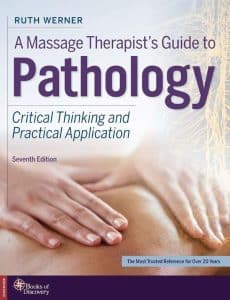
Massage Therapist’s Guide to Pathology
By Ruth Werner (7th Edition, 2023)
Massage Therapist’s Guide to Pathology: Critical Thinking and Practical Application is a comprehensive resource that offers in-depth information on over 500 diseases and disorders relevant to massage therapy. Ruth Werner provides detailed insights into the etiology, signs, symptoms, and treatment considerations for a wide range of conditions, including potential massage side effects, helping therapists make informed decisions to ensure client safety and effective treatment.
Why It’s Worth Reading
Understanding pathology for massage therapists is a vital part of providing safe and effective treatments. This guide equips you with the knowledge to recognize various health conditions and adapt your massage techniques accordingly, enhancing client outcomes and building trust.
What You’ll Gain
- Extensive Pathology Knowledge: Learn about conditions affecting all body systems, from the integumentary to the nervous system.
- Critical Thinking Skills: Develop the ability to assess massage contraindications and modify treatments based on individual client needs.
- Evidence-Informed Practice: Stay updated with the latest research and best practices in massage therapy.
Unique Features
- User-Friendly Format: Organized chapters and quick-reference tables make it easy to find relevant when preparing for a client sessions or working on creating an appropriate client treatment plan.
- Practical Application: Includes real-world case studies and scenarios to help you apply knowledge in your practice, especially for therapists who offer medical massage.
- Educational Tools: Features review questions and summaries to reinforce learning and support continuing education.
My Experience
Massage Therapist’s Guide to Pathology has been a helpful reference in my practice. It has deepened my understanding of how various health conditions can impact the application of massage therapy techniques, allowing me to tailor my approach for each individual client.
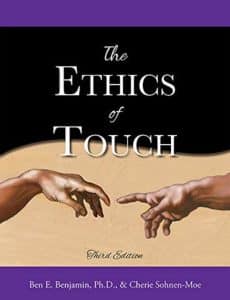
The Ethics of Touch
By Cherie Sohnen-Moe & Ben Benjamin (3rd Edition, 2020)
The Ethics of Touch is a vital resource that explores the professional and ethical issues unique to massage therapists and bodyworkers. The book provides clear guidance on establishing boundaries, handling ethical dilemmas, and communicating effectively with clients. It offers practical tools to help therapists navigate complex situations with confidence and integrity.
Why It’s Worth Reading
For massage therapists dedicated to upholding high ethical standards, this book is indispensable. It covers into the nuances of professional conduct within the context of touch therapies, ensuring you can build trusting therapeutic relationships while maintaining appropriate boundaries.
What You’ll Gain
- Comprehensive Ethical Understanding: Learn about the core principles that govern ethical decision-making in massage therapy.
- Practical Solutions: Discover strategies for addressing common ethical challenges, such as dual relationships, how to handle difficult clients, and confidentiality concerns.
- Enhanced Communication Skills: Improve your ability to answer client questions discuss sensitive topics with clients, fostering open and honest dialogue.
Unique Features
- Real-World Scenarios: Includes case studies that illustrate typical ethical issues and how to resolve them effectively.
- Interactive Exercises: Reflective questions and activities encourage personal growth and self-awareness.
- Up-to-Date Information: The third edition incorporates the latest developments in ethical practices and standards within the industry.
My Thoughts
The Ethics of Touch has provided me with some practical tools to handle ethical situations thoughtfully, ensuring that I can offer the highest level of care while respecting my clients’ needs and boundaries.
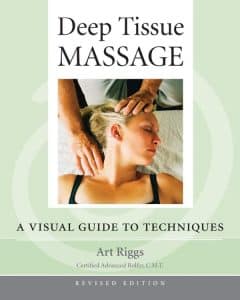
Deep Tissue Massage
By Art Riggs (2007)
Deep Tissue Massage by Art Riggs is a thorough exploration of the techniques and principles behind deep tissue bodywork. This book provides massage therapists with detailed instructions on how to apply deep pressure techniques skillfully and safely, making it a valuable addition to any professional library.
Why It’s Worth Reading
For therapists looking to enhance their expertise in deep tissue massage, this guide offers practical insights and methods that can be immediately applied in practice. It emphasizes the importance of body mechanics, touch sensitivity, and client positioning to deliver effective treatments without causing strain to the therapist.
What You’ll Gain
- Advanced Techniques: Learn a variety of strategies to address chronic muscle tension and specific client issues.
- Improved Body Mechanics: Understand how to use your hands, fists, forearms, elbows, and tools efficiently to protect your hands and prevent self-injury.
- Client-Centered Approach: Discover how to tailor your massage sessions to meet individual client needs and promote healing.
Unique Features
- Extensive Visual Aids: The book includes over 250 photographs and anatomical drawings that clearly illustrate techniques and muscle structures.
- Practical Guidance: Offers step-by-step instructions and treatment plans for different areas of the body.
- Professional Insights: Shares the author’s experience and tips for integrating deep tissue work seamlessly into your existing practice.
My Experience
Incorporating the techniques from Deep Tissue Massage has enhanced the effectiveness of my treatments. The focus on proper body mechanics has served as a much needed reminder to maintain my own physical well-being as a therapist.
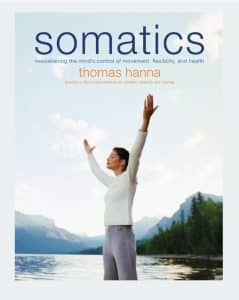
Somatics
By Thomas Hanna (2004)
Somatics: Reawakening The Mind’s Control Of Movement, Flexibility, And Health discusses how we can regain conscious control over our muscles to improve movement, flexibility, and overall health. Thomas Hanna introduces gentle exercises designed to retrain the brain’s connection with the muscular system, helping to reverse the effects of stress, injury, and habitual patterns that lead to chronic pain and stiffness. While Somatics shares similarities with other somatic practices such as the Feldenkrais Method and Hellerwork, which also emphasize body awareness and movement re-education, it maintains its own unique methodologies and theoretical framework. This distinction provides massage therapists with diverse approaches to enhance client flexibility and promote long-term physical well-being, making it a valuable resource for integrating mindful movement into therapeutic practices.
Why It’s Worth Reading
For massage therapists interested in the mind-body connection and neuromuscular education, this book offers valuable insights. It provides techniques that can enhance your practice by helping clients overcome sensory-motor amnesia—a condition where the brain forgets how to control certain muscles—resulting in improved flexibility and reduced discomfort.
What You’ll Gain
- Understanding of Sensory-Motor Amnesia: Learn how unconscious muscle contractions contribute to pain and how to address them.
- Practical Exercises: Discover simple movements that you can teach clients to help them regain control over their bodies.
- Holistic Client Care: Integrate somatic principles into your sessions to tackle the root causes of musculoskeletal issues.
Unique Features
- Accessible Language: Complex concepts are explained in straightforward terms, making them easy to understand and apply.
- Mind-Body Integration: Emphasizes the importance of awareness and conscious movement in promoting healing.
- Long-Term Benefits: Offers a lifelong program that requires minimal time but delivers lasting results in flexibility and health.
My Thoughts
Incorporating Somatics techniques into massage therapy sessions when appropriate can enhance your ability to improve client mobility and flexibility, as well as potentially relieve chronic pain. By combining somatic exercises with therapeutic massage, you can provide a comprehensive approach to healing, supporting physical recovery and fostering body awareness.

Business Mastery
By Cherie Sohnen-Moe (5th Edition, 2016)
Business Mastery: A Guide for Creating a Fulfilling, Thriving Practice, and Keeping it Successful is a comprehensive guide aimed at helping massage therapists build and sustain a successful and rewarding practice. Cherie Sohnen-Moe provides practical advice on topics such as marketing strategies, financial management, ethical practices, creating massage policies and procedures, building a website for your practice, selling massage products, offering massage add-ons, getting word-of-mouth referrals, and personal development. This book equips you with the supplemental tools needed to create a fulfilling massage career while effectively managing the business side of massage therapy.
Why It’s Worth Reading
For massage therapists seeking to grow their client base or start a new venture, this book offers invaluable insights. It covers essential aspects of running a massage practice, including attracting and retaining clients, developing effective marketing plans, choosing the right location for your massage business, selecting the right massage equipment, developing good record keeping and massage documentation habits, and handling the day-to-day operations of a massage therapy business.
What You’ll Gain
- Effective Business Strategies: Learn how to set clear goals, create a dynamic massage business plan, and implement marketing techniques tailored to your practice.
- Financial Management Skills: Gain insights into budgeting, pricing massage services appropriately, and increasing profitability.
- Professional Growth: Discover ways to enhance customer service, build professional networks, and maintain a healthy work-life balance.
Unique Features
- Comprehensive Coverage: Addresses both the practical and psychological aspects of running a massage therapy business, from massage insurance to avoiding burnout.
- Interactive Tools: Includes exercises, massage forms and templates, and checklists to help you apply concepts directly to your practice.
- Updated Content: The fifth edition incorporates new information on online marketing, social media engagement, using effective technology like online booking and massage software, and the latest industry trends.
My Experience
A previous edition of Business Mastery has been instrumental in the early success of my practice. The actionable advice and practical tools have given me ideas on streamlining my operations, attracting ideal clients in my target market, developing seasonal marketing campaigns, inspiring ideas for massage specials, and jumpstarting a rewarding career in massage therapy.

Molecules Of Emotion
By Candace Pert (1999)
In Molecules Of Emotion: The Science Behind Mind-Body Medicine, neuroscientist Candace Pert explores the biochemical connections between the mind and body, revealing how our emotions can influence our physical health. Through her groundbreaking research on neuropeptides and their receptors, she uncovers the science behind the mind-body connection, offering insights that challenge traditional views of medicine and healing.
Why It’s Worth Reading
For massage therapists interested in holistic health and the interplay between emotions and the physical body, this book provides a scientific foundation for understanding how emotional states can impact physiological processes. It offers valuable perspectives that can enhance your approach to client care, emphasizing the importance of addressing both mental and physical aspects of well-being.
What You’ll Gain
- Understanding of Mind-Body Medicine: Learn about the biochemical pathways that link emotions to physical health.
- Enhanced Client Care: Gain insights into how emotional stress can manifest as physical symptoms, allowing you to tailor your massage therapy sessions more effectively.
- Inspiration for Holistic Practice: Discover how integrating knowledge of the mind-body connection can lead to more comprehensive healing strategies.
Unique Features
- Personal Narrative: Candace Pert shares her journey as a scientist, providing an engaging and relatable context for the scientific concepts discussed.
- Groundbreaking Research: Presents pioneering studies on neuropeptides and their role in emotion and immunity.
- Accessible Language: Complex scientific ideas are explained in a way that is easy to understand, making the book suitable for readers without a scientific background.
My Experience
Reading Molecules Of Emotion has deepened my appreciation for the intricate connections between the mind and body. It has influenced the way I approach massage therapy, encouraging me to consider the emotional well-being of my clients as an integral part of their physical health. This holistic perspective has enhanced the effectiveness of my treatments and strengthened my client relationships.

The Body Keeps the Score
By Bessel van der Kolk, MD (2015)
In the book The Body Keeps the Score: Brain, Mind, and Body in the Healing of Trauma, psychiatrist Bessel van der Kolk explores how traumatic experiences imprint themselves on both the mind and body. Drawing from decades of research and clinical practice, he writes about the ways trauma reshapes the brain’s wiring, affecting emotions, impulses, and relationships. The book highlights the interconnectedness of brain, mind, and body in the healing process.
Why It’s Worth Reading
For massage therapists, especially those working with clients who have experienced various forms of trauma such as PTSD, physical or emotional abuse, combat exposure, or accidents, understanding the profound impact of trauma on the human body is essential. This book offers valuable insights into how physical touch and bodywork can aid in healing psychological wounds. It emphasizes the role of somatic therapies in restoring balance and fostering recovery, providing therapists with a deeper understanding of the intricate connections between trauma and physical health. By exploring how trauma reshapes both the brain and the body, this book equips massage therapists with the knowledge to create more effective and compassionate treatment plans that address both the mental and physical aspects of healing.
What You’ll Gain
- In-Depth Knowledge of Trauma: Learn about the neurobiology of trauma and its effects on behavior and physiology.
- Holistic Treatment Approaches: Discover therapeutic techniques that integrate body and mind, such as mindfulness, yoga, and movement therapies.
- Enhanced Empathy and Care: Understand how to create a safe space for clients who have experienced trauma, improving therapeutic outcomes.
Unique Features
- Real-Life Case Studies: The book includes compelling stories that illustrate the challenges and triumphs of trauma survivors.
- Evidence-Based Research: Grounded in scientific studies, it provides a solid foundation for the practices it recommends.
- Integrative Perspective: Bridges the gap between traditional psychotherapy and body-centered therapies.
My Experience
Reading The Body Keeps the Score has provided me with new insights into the hidden struggles many clients face and taught me the importance of integrating somatic awareness into my practice. By applying the principles from this book, I’ve been able to support my clients more effectively on their healing journeys.
Additional Massage Book Recommendations
To further support your growth as a massage therapist, here are a few additional books that offer valuable insights which deserve an honorable mention. These titles didn’t make our top 15 book list but are highly beneficial for expanding a massage practitioner’s knowledge and skillset.
Books by Leon Chaitow
Leon Chaitow was a renowned osteopath and naturopath who authored numerous essential books for massage therapists and other manual therapists. His works often focus on soft tissue manipulation, neuromuscular techniques, and holistic approaches to healing.
Notable Titles:
- Clinical Application of Neuromuscular Techniques (with Judith DeLany) This two-volume set provides in-depth guidance on neuromuscular techniques, combining theoretical knowledge with practical applications to address chronic pain and musculoskeletal dysfunctions.
- Positional Release Techniques This book explores gentle bodywork methods that alleviate muscle spasm and pain by placing the body in positions of comfort.
- Muscle Energy Techniques An informative guide on using muscle energy techniques to improve joint function and reduce muscle tension.
Why His Work Is Worth Reading
- Comprehensive Techniques: Learn advanced methods for assessing and treating soft tissue disorders.
- Holistic Approach: Understand how to integrate osteopathic principles into your massage practice effectively.
- Evidence-Based Practice: Benefit from Chaitow’s extensive research and clinical experience.
Anatomy of Change by Richard Strozzi-Heckler
This book explores the connection between physical movement and personal transformation. Richard Strozzi-Heckler discusses how awareness of the body can lead to profound changes in behavior and mindset.
Why It’s Worth Reading
- Mind-Body Integration: Gain insights into how movement practices can facilitate personal growth.
- Enhance Client Sessions: Learn techniques to help clients achieve greater self-awareness and healing.
- Somatic Coaching: Explore methods to incorporate somatic principles into therapeutic relationships.
A Guide to Better Movement: The Science and Practice of Moving with More Skill and Less Pain by Todd Hargrove
Todd Hargrove offers a scientific yet accessible exploration of how movement affects pain and performance. The book provides practical advice on improving movement quality to reduce pain and enhance physical function.
Why It’s Worth Reading
- Evidence-Based Insights: Understand the latest research on pain science and motor control.
- Practical Exercises: Access strategies to help clients move more efficiently and comfortably.
- Client Education: Learn ways to teach clients about movement to support their healing process.
Clinical Massage Therapy: Understanding, Assessing and Treating Over 70 Conditions by Fiona Rattray and Linda Ludwig
Although out of print and hard to find, this comprehensive textbook is a valuable resource covering a wide range of conditions that massage therapists may encounter.
Why It’s Worth Reading
- Extensive Condition Coverage: Learn assessment and treatment protocols for over 70 different conditions.
- In-Depth Knowledge: Enhance your ability to create eff1ective treatment plans based on individual client needs.
- Professional Reference: A go-to guide for evidence-informed massage therapy practices.
The Educated Heart: Professional Boundaries for Massage Therapists and Bodyworkers by Laura Allen
This book addresses the crucial topic of maintaining professional boundaries in massage therapy. It offers practical guidance on handling complex situations with clients while upholding ethical standards.
Why It’s Worth Reading
- Boundary Setting Skills: Learn how to establish and maintain appropriate professional relationships.
- Ethical Practice: Understand the importance of ethics in building a successful and trustworthy practice.
- Real-Life Scenarios: Benefit from examples that illustrate common challenges and effective responses.
Bodymind by Ken Dychtwald
Ken Dychtwald explores the interconnectedness of the body and mind, discussing how psychological factors can manifest physically. The book provides insights into holistic healing and personal transformation.
Why It’s Worth Reading
- Holistic Perspectives: Gain a deeper understanding of the relationship between mental and physical health.
- Client Care Enhancement: Apply concepts that address both emotional and physical aspects of well-being.
- Personal Growth: Reflect on your own bodymind connection to become a more empathetic practitioner.
The Web That Has No Weaver: Understanding Chinese Medicine by Ted Kaptchuk
This book offers an in-depth look at traditional Chinese medicine (TCM), explaining its principles and practices. It provides a different perspective on health and healing that can complement Western approaches.
Why It’s Worth Reading
- Alternative Healing Insights: Learn about TCM concepts such as Qi, meridians, and balance.
- Integrative Practice: Consider how to incorporate Eastern philosophies into your massage therapy services.
- Cultural Understanding: Broaden your knowledge of diverse healing traditions to better serve a variety of clients.
These additional books offer valuable knowledge that can enhance your massage therapy practice. Whether you’re interested in advanced techniques, ethical considerations, or holistic approaches, exploring these titles can provide new perspectives and tools to support your professional development.
Embracing Lifelong Learning
In the field of massage therapy, committing to lifelong learning is essential for personal growth and professional excellence—qualities that clients highly value in a massage therapist. Continuously expanding your technical skills, soft skills, and knowledge not only enhances client outcomes but also keeps your practice engaging and helps prevent burnout.
Practical Tips for Ongoing Education
- Pace Your Learning: With so much to explore, it’s important to integrate new ideas gradually. Give yourself time to assimilate and apply new concepts to avoid feeling overwhelmed.
- Resourceful Reading: Save money by purchasing used massage books or visiting your local library—both public and university libraries can be treasure troves of valuable information.
- Maintain Perspective: As you adopt new techniques and theories, remember to balance them with established practices. Avoid viewing everything solely through the lens of recent learnings to ensure a well-rounded approach.
- Refresh Foundational Knowledge: If you’re returning to massage therapy after some time away, consider revisiting core textbooks commonly used in massage schools to reinforce fundamental concepts.
By embracing a growth mindset of being a “learn-it-all” rather than a “know-it-all,” you open yourself up to continual improvement and discovery in your massage therapy career.
Conclusion
Investing time in your professional development as a massage therapist, whether you work full-time or offer massage as a side-hustle, brings benefits to both you and your clients. The massage therapy books I’ve highlighted offer valuable knowledge, from refining hands-on techniques to expanding your understanding of the mind-body connection and improving your business skills. By exploring these massage resources, you equip yourself with tools to elevate your practice, stay informed about industry advancements, and provide exceptional care.
Learning is a continuous process. Embracing new ideas keeps your work engaging and fosters growth that benefits everyone you serve. Whether you’re beginning your career or have years of experience, there’s always something new to discover in the field of massage therapy.
